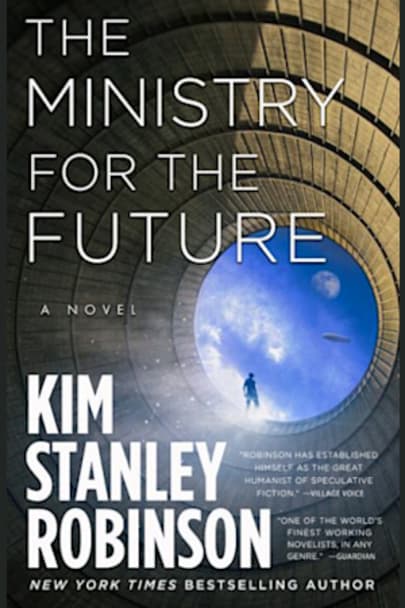From legendary science fiction author Kim Stanley Robinson comes a remarkable vision of climate change over the coming decades.
The Ministry for the Future is a masterpiece of the imagination, using fictional eyewitness accounts to tell the story of how climate change will affect us all. Its setting is not a desolate, postapocalyptic world, but a future that is almost upon us — and in which … a future that is almost upon us — and in which we might just overcome the extraordinary challenges we face.
It is a novel both immediate and impactful, desperate and hopeful in equal measure, and it is one of the most powerful and original books on climate change ever written.
“A breathtaking look at the challenges that face our planet in all their sprawling magnitude and also in their intimate, individual moments of humanity.” — Booklist (starred)
“A sweeping, optimistic portrait of humanity’s ability to cooperate in the face of disaster. This heartfelt work of hard science-fiction is a must-read for anyone worried about the future of the planet.” — Publishers Weekly (starred)
Also by Kim Stanley Robinson:
Red Moon
New York 2140
2312
Aurora
Shaman



It’s fiction but it faces the reality of the future we must all face. Science fiction is known for predicting what will happen, except climate change is already happening. Well worth the time to read.
*The Ministry for the Future* addresses the ravages of the climate crisis and what we can do about it. The book is chock full of compelling ideas, and unlike most climate fiction books, it ends on a hopeful note. The book opens with a detailed and difficult-to-read description of a horrendous wet-bulb heat event in India in which 20,000 people die. Present at this event is a young American, Frank May. He manages to survive, but life will never be easy for him after this. The wet bulb heat event sets the tone for his life and for the book.
Unlike most novels which have a set of characters moving through a plot, Frank is only one of two characters that we follow in this near-future science fiction book The other major character is Irishwoman Mary Murphy, chief administrator of the Ministry for the Future, an international agency with the mission of representing future life forms and protecting them from the deleterious effects of climate change. In addition to Frank and Mary, *Ministry* moves around from first and third person narration throughout the book to allow for numerous perspectives.
Various ideas of how to cope with the climate crisis are investigated, among them mass citizen protests and organized acts of violence. The international system of capitalism is the primary villain in this story (as it is in reality), and the manipulation of the international banking and finance system becomes key to changing everything. In fact, Robinson goes so deep in the weeds investigating how to change the finance system that at times that the book turns into a “how-to” rather than real storytelling.
Despite these shortcomings, we must recognize Robinson’s original approach to this very difficult subject. He gives us a lot to think about and a measure of hope that we can change the trajectory of the climate crisis before it does us all in.
This was a tough read, even for KSR, but it was well worth the effort.
As we live in a dystopian time Robinson creates an alternative conclusion to a world facing a threatened future.
The writing is beautiful.
I’m coming from an odd perspective, as the author of another climate catastrophe series. In the opening chapters of this book, free as a sample, Robinson achieves my goal with my own series: to make the danger breathe, make it real, make it personal. Climate change may seem abstract, and the danger arguable for future generations, not yourself. Economic discomfort – that we’re all too aware of, and the oil industry can play on our fears. But climate change is not someday, it’s now. And like COVID, its global reach is too potent for business as usual arguments to apply.
In one of my favorite passages, the author mentions that oil industry execs, sitting upon thousands of trillions of carbon yet to be unleashed, are good well-meaning people. Those who naysay the urgency of decarbonizing are not evil goons. But their actions can still destroy the planet.
As I write this, COVID cases are climbing a vertical wall in India, not a surge but a catastrophe, with cremation sites melting from overuse, making this book’s opening scenes in Uttar Pradesh particularly poignant.
Read this book. And then act within your own sphere. It’s not too late, but getting awfully close.
For anyone interested in climate change (and how can you not be?) this is a great book. The opening chapter is riveting. After that, you’ll get a lot of good information woven into a story. Sometimes that information is not really woven into the story but served up in paragraphs (sorry about the mixed metaphor) that more resemble nonfiction. But I am not complaining. The more information about global warming, the better. I am particularly interested in information I don’t already have, and that is true here when the author starts talking about the economics of solving global warming: carbon credits and carbon taxes and the role of banks. Some of the other solutions to global warming are shocking. I won’t spoil the book for you. I highly recommend it. This isn’t literature so much as compelling and urgent social commentary and analysis. In story form. Which is part of the legacy and role of science fiction.